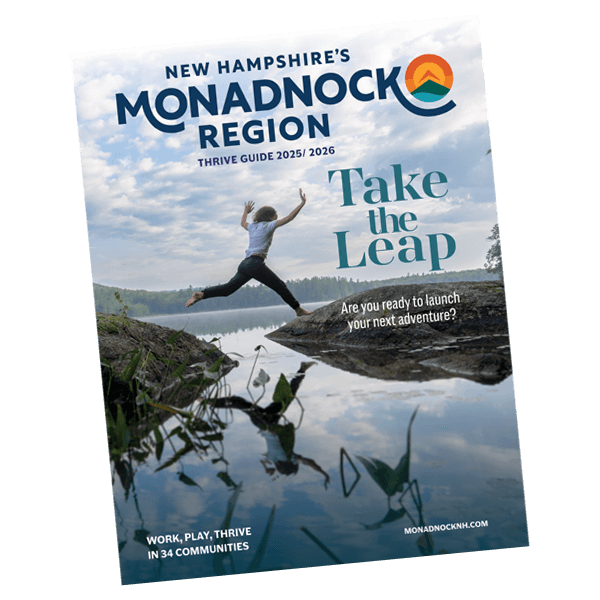Deepening roots and branching out
By Sarah Pearson
The conditions around Mount Monadnock support trees like spruce, birch and oak, and shrubs like mountain cranberry, wild blueberry and sheep laurel. Eight rare species can be found amid the fens and forests. Their roots intermingle, sharing water and nutrients from the soil. That connection gives strength. A tree on its own might not withstand a heavy gust, but when rooted within the forest, its neighbors keep it grounded despite the gales that come.
That variety of plant life contributes to the health of the woods. Biodiversity enhances the resilience of ecology, providing food sources for wildlife, converting carbon dioxide into oxygen and filtering the snowmelt that feeds a trio of major rivers and over a dozen refreshing lakes.
Much like the natural environment, a confluence of conditions has grown a strong community of people in the shadow of the mountain. It’s a phenomenon so noticeable here that two of the foremost thought leaders on “social capital” have made the Monadnock Region their home.
In their book “The Upswing,” Shaylyn Romney Garret and Robert Putnam unpack the changing trends of the early 20th century that increased greater human connectedness. Civic groups like PTAs, bowling leagues and religious organizations brought communities together, with their impact peaking in the 1970s. Since that peak, social capital has been on the decline nationally, for a myriad of reasons. Romney Garret made the decision to move her family here after writing this book with Robert at his family’s home in the region. With the decline of social capital very much on her mind, she was struck by the level of neighborliness.
“There are a lot of initiatives across the nation to kickstart community again,” Romney Garrett says. “Civic groups have begun to clue into this to … reweave the social fabric.”
“It’s not an accident that Bob and I chose to live in the Monadnock Region,” she told the Keene Sentinel in 2022. “The social capital numbers in this region are very high. And you can feel that, not just see it on the charts.”
The region has several factors contributing to this:
There is proximity to the brain trusts of Boston and New York, but the rural atmosphere lends itself to a more human pace of life.
“It’s a unique level of cultural effort in a rural area,” Romney Garrett says.
Additionally, the New England style of governance, where many decisions are made at the town level, rather than county-wide, means that the community is more attuned to the issues that most directly impact them. New Hampshire is also politically diverse, which means residents are having conversations with neighbors who may have viewpoints that are different than their own.
Romney Garrett says economically diverse neighborhoods are another way to build social capital and that it’s important to not only be surrounded by people who are like each other. It’s something she’s seen in her neighborhood where there are large single-family homes near multi-unit buildings.
The Monadnock area population has a high education level and is home to Keene State College, Franklin Pierce University, River Valley Community College and Antioch University.
Research into social capital shows a link between education and civic participation and New Hampshire “earns high marks at all levels of education” according to NH BEA.
Just as Mount Monadnock’s flora and fauna have created an environment of symbiosis, the people here are working to create a stronger community.
Possibly the largest display of community volunteerism happens every year in September, when Keene’s Elm City Rotary Club and a crew of some 400 volunteers come together each fall to organize the Clarence Demar Marathon and Half Marathon. That’s just about one volunteer per racer, so runners will get a lot of care. The race is truly a community effort, and now also offers kids and seniors wellness runs. The 46-year-old race honors former Keene resident Clarence Demar, the only runner to win the Boston Marathon seven times. Racers can take in the beauty of the Monadnock’s fall foliage as they run through the woods, past Surry Mountain Lake and into downtown Keene, with the finish line near Keene State College, where Demar coached runners.
Throughout the region, you’ll find fans coming together to root for the home team. Recently, Keene State’s men’s basketball team became the first in 29 years to win three straight Little East Conference championships, and Franklin Pierce University men’s soccer has been champions for the last two years. You won’t just find students and staff in the stands, alumni and a wider audience of neighbors are there, cheering and connecting with the collegiate community.
Some members of the community liaise at contra dances. The Monadnock Folklore Society organizes two options, weekly dances on Mondays in Nelson and a monthly dance on the first Saturday in Peterborough. Meeting new neighbors is at the heart of these community dances. They say if you can smile and walk, you can contra dance.
Together in times of celebration, together in times of grief: Cathedral of the Pines offers an open-air non-denominational sanctuary to honor the military service of American men and women. Community events, like a writer’s group or a butterfly release, are held throughout the year and it is also available for private gatherings, like weddings or celebrations of life.
Civic groups throughout the region are rooted in service. Scouting groups, Lions and Rotary clubs and other groups weave the social fabric of the region. Organizations such as the United Way, The Community Kitchen and Monadnock Area Transitional Shelter work to make sure neighbors’ basic needs are met.
Personal and entrepreneurial advancement is also a community endeavor. MAXT Makerspace in Peterborough offers a gathering point for people to share resources, tools and knowledge, allowing people to work on projects and build up businesses. Meanwhile, entrepreneurs supported by Keene’s Hannah Grimes Center on average see success about triple that of other New Hampshire start-ups.
Some of those growth efforts are focused on connecting with those who have historically been left out. Through the Keene YMCA, the Monadnock Diversity, Equity, Inclusion & Belonging Coalition is working on making the region a welcoming place for all individuals.
History has shown that people do better when they are part of a strong social network.
“Community ties have value,” Romney Garrett says.
Together, the people of the Monadnock community have built a vibrant and ideal place to visit, live, learn and work. It’s both exactly what you’d expect to find in rural Southwestern New Hampshire – beautiful nature, local farms, and quaint towns – and also full of surprises, like high-tech innovative companies; events like Keene Pride Week, the International Festival, Picklefest and Radically Rural; or emotional live performances, where the talent may be the New York Theatre Ballet or a restaurant owner who choregraphed a dance with other parents to raise money for the arts. At the end of the day, what matters most here is that we’re all in this together.
“There is something really special in the Monadnock region,” Romney Garrett says. “You can really feel it.”






